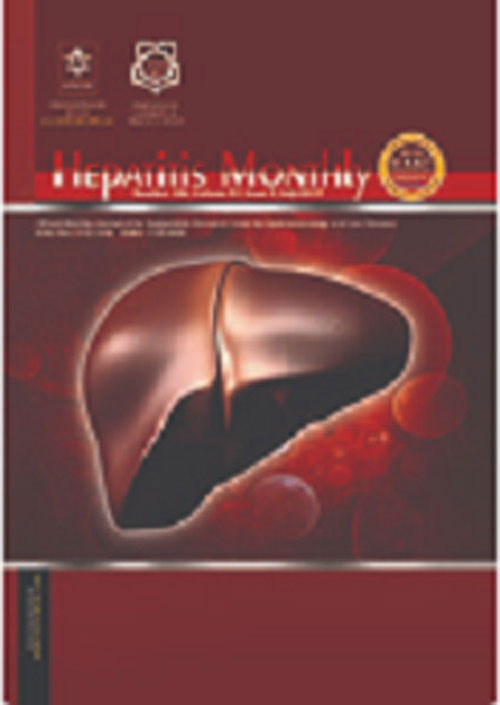فهرست مطالب

Hepatitis Monthly
Volume:19 Issue: 11, Nov 2019
- تاریخ انتشار: 1398/09/26
- تعداد عناوین: 4
-
-
Page 1Objectives
This study was conducted to evaluate the efficacy of a combination therapy using aspirin (also known as acetylsalicylic acid (ASA)) and atorvastatin in comparison with atorvastatin alone to improve liver fibrosis and function in patients with cryptogenic cirrhosis.
MethodsIn this randomized double-blinded clinical trail, 40 patients with cryptogenic cirrhosis were randomly allocated to the intervention group (atorvastatin + ASA) and the control group (atorvastatin) treated for six months. Then liver function and stiffness (based on transient electrography) were compared. A checklist was used for data collection and the results were analyzed by SPSS 24 using chi-square test and paired t-test at the 0.05 significance level.
ResultsA total of 33 cases, including16 patients in group A (atorvastatin + ASA) and 17 in group B (atorvastatin + placebo) with a mean age of 50.3 ± 11.2 and 47.9 ± 10.6 years and BMI of 30.7 ± 4.2 and 30.8± 3.1 in groups A and B, were studied, respectively. Twelve patients (75%) in group A and 14 cases (82%) in group B were male. Both groups were homogenized in terms of demographic information at baseline. A significant improvement in Child score (P = 0.001 and P = 0.002 for groups A and B, respectively) and liver stiffness (P < 0.0001 and P = 0.007 for groups A and B, respectively) were observed in both groups after the intervention, however there was no significant improvement in child score (P = 0.982) and liver stiffness (P = 0.611) in comparing both groups.
ConclusionsAlthough atorvastatin is effective in improvement of liver fibrosis and function in cryptogenic cirrhosis, adding ASA cannot improve its effects.
Keywords: Cryptogenic Cirrhosis, Atorvastatin, Aspirin, Liver Fibrosis, Liver Stiffness -
Page 2Background
Hepatitis B virus (HBV) is responsible for chronic hepatitis B (CHB) and liver diseases. In the event of seroclearance or seroconversion, hepatitis B surface antigen (HBsAg) may be cleared or reduced to levels below the detection limit but very low quantities of viral DNA may be detectable as occult HBV infection (OBI).
ObjectivesThis study was conducted to estimate the prevalence of HBV DNA in the serum and PBMCs of individuals with HBsAg loss, with or without anti-HBs.
MethodsSixty out of 1116 patients who referred to the private clinic were selected and divided into two groups: serocleared and seroconverted. Serological markers of HBV were measured by ELISA assay and HBV DNA in the plasma and peripheral blood mononuclear cell (PBMC) were measured by quantitative real time PCR.
ResultsA total of sixty cases (38 males, 22 females) with chronic hepatitis B were enrolled. The mean age of serocleared and seroconverted groups was 50.5 ± 13.1and 49 ± 11, respectively. Among the serocleared and seroconverted subjects, 3 and 2 became HBsAg positive, respectively. HBV DNA was detected in the PBMCs of four out of 27 serocleared patients (14.8%) and three out of 28 seroconverted (10.7%). By multivariate analysis, age, gender, duration of disease and serological situation of patients had no effects on patients’ relapse (P > 0.05).
ConclusionsIn patients with CHB, who became HBsAg negative if the serum antibody is formed, there is a possibility of disease recurrence. Moreover, recurrence may be predicted considering the viral load in PBMCs.
Keywords: Chronic Hepatitis B_Occult HBV Infection_Hepatitis B Surface Antigen -
Page 3Background
Liver fibrosis is one of the chronic hepatitis B (CHB) indications for treatment.
ObjectivesWe aimed to assess the fibrosis index, FIB-4, King’s fibrosis score, albumin-bilirubin (ALBI) score, gamma-glutamyl transferase-platelets (GPR), and gamma-glutamyl transferase-albumin (GAR) ratios as diagnostic models of liver fibrosis in CHB patients.
MethodsThe study enrolled 217 patients. Liver fibrosis was assessed by transient elastography, which showed 20.3% of the patients had F4 fibrosis. Treatment was given for 33.20 ± 20.94 months.
ResultsF4 fibrosis patients had higher values (P = 0.001) of Fibrosis index score, FIB-4 score, King’s fibrosis score, ALBI score, GPR, and GAR than non-F4 fibrosis patients. All patients had improved values after treatment. The mean treatment-induced changes were comparable in patients with and without virological response. The Fibrosis index of > -32.66 showed 63.64% sensitivity and 91.33% specificity. The FIB-4 score of > 1.88 had 72.73% sensitivity and 91.33% specificity. The King's fibrosis score of > 7.93 demonstrated 90.91% sensitivity and 73.99% specificity. The ALBI score of > -2.7 had 70.45% sensitivity and 86.13% specificity. The GPR value of > 0.69 revealed 70.5% sensitivity and 94.2% specificity. The GAR value of > 1.28 showed 72.73% sensitivity and 46.4% specificity. The GAR was inferior to FIB-4 and GPR (P < 0.05).
ConclusionsGPR, fibrosis index, King’s fibrosis score, ALBI, and FIB-4 are useful diagnostic models of liver fibrosis in CHB patients.
Keywords: GPR, Fibrosis Index Score, FIB-4, King’s Fibrosis Score, ALBI, GAR


